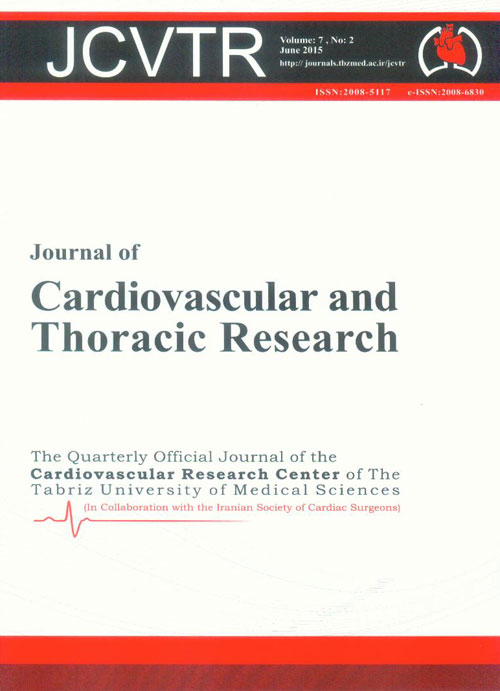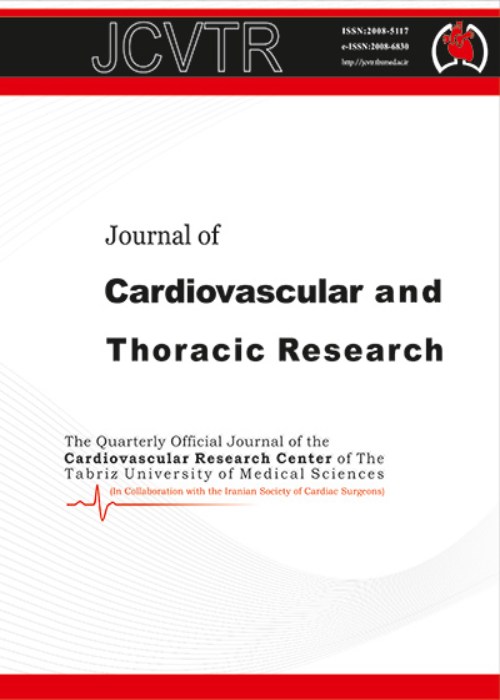فهرست مطالب

Journal of Cardiovascular and Thoracic Research
Volume:7 Issue: 2, Jun 2015
- تاریخ انتشار: 1394/04/01
- تعداد عناوین: 9
-
-
Pages 43-48BackgroundThe practice of low vs. high sedation dosing strategy may impact the cognitive and mental health function in the intensive care unit (ICU). We aim to demonstrate that high sedation strategy will result in change of mental health function in ICU patients.MethodsWe performed a systemic search and meta-analysis of medical databases in MEDLINE(from 1966 to March 2013) and EMBASE (from 1980 to March 2013), as well as the Cochrane Library using the MESH terms “Intensive Care Unit,” and “Mental Health, for assessing the impact of sedation on posttraumatic stress disorder (PTSD) or anxiety/depression and deliriumin the mix ICU setting including cardiac surgery patients. A total of 1216 patients were includedin the final analysis.ResultsWe included 11 studies in the final analysis and concluded that high dose sedationstrategy resulted in higher incidence of cognitive dysfunction with P value of 0.009. Theresult for subgroup of delirium showed P = 0.11 and PTSD/depression or anxiety of P = 0.001,Heterogeneity I2 was 64%. Overall analysis was statistically significant with a P value of 0.002.ConclusionHigh sedation dosing strategy will negatively affect cognitive function in criticallyill patients. Large randomized trials are needed to address cognitive dysfunction in subgroup of patients with delirium.Keywords: Posttraumatic Stress Disorder, Depression, Cognitive Function, Sedation, Delirium, Cognitive Function
-
Pages 49-54IntroductionThe cardiopulmonary bypass may have multiple systemic effects on the body organsas liver. This prospective study was planned to explore further the incidence and significance ofthis change.MethodsTwo hundred patients with coronary artery bypass grafting (CABG), were randomlyselected for the study. Total and indirect bilirubin, aspartate aminotransferase, alanineaminotransferase, alkaline phosphatase were measured preoperatively and at 24, 48 and 72hours, following coronary artery bypass grafting. Postoperative value of the liver function testswith respect to hypothermia or hypotension were compared by one way analysis of variance forrepeated measure and compared with t test. Patient’s characteristics with bilirubin value (≤1.5 mgor >1.5 mg) were compared with t test.ResultsA significant increase of total bilirubin, aspartate aminotransferase, and alkalinephosphatase were noted in the third postoperative day. Significant relation was seen betweenhypotension and alkaline phosphatase, and aspartate aminotransferase change but hypothermiahad not affected alanine aminotransferase, total bilirubin and indirect bilirubin change. Pumptime, alanine aminotransferase in third postoperative day and direct bilirubin in first and secondday of postoperative period had significant relation with pre and post-operative bilirubin change.ConclusionTransient but not permanent alterations of hepatic enzymes after coronary arterybypass grafting presumably attributed to the decreased hepatic flow, hypoxia, or pump-inducedinflammation.Keywords: Coronary Arteries Bypass Grafting, Livers, Hepatic Enzymes
-
Pages 55-59IntroductionSerum amyloid-A (SAA) and protein carbonyl group are rigorously related with cardiovascular diseases (CVDs) as a sensitive marker of an acute inflammatory state and as an important index of oxidative stress, respectively. Moreover, diet is one of the main factors that canmodify cardiovascular risks. Therefore, this study aimed to investigate the effects of Ramadanfasting on SAA and protein carbonyl group levels in patients with CVDs.MethodsTwenty-one patients (21 male; mean age 52±9 years old) with CVDs (coronaryartery disease, cerebrovascular, or peripheral arterial diseases) were participated in this study.Biochemical parameters were measured in patients 2 days before and 2 days after Ramadanfasting. SAA levels were assessed using enzyme-linked immunosorbent assay and Cayman’sprotein carbonyl colorimetric assay was provided for measuring protein carbonyl groups.ResultsAccording to the findings of the study, post-Ramadan levels of inflammatory biomarker,SAA was decreased significantly in patients with CVDs in comparison with the baseline beforefastingvalues (16.84±8.20 vs. 24.40±6.72 μg/ml, P = 0.021). In addition, Ramadan fastingsignificantly reduced the levels of protein carbonyl group in patients as compared with those ofbaseline values (33.08±15.31 vs. 43.65±16.88 nmol/ml, P = 0.039).ConclusionRamadan fasting has impressive effects on modulating CVDs by decreasinginflammation and oxidative stress markers. However, to get a clear conclusion with more results,further investigation is warranted.Keywords: Cardiovascular Diseases, Fasting, Protein Carbonylation, Serum Amyloid, A Protein
-
Pages 60-62IntroductionCardiovascular diseases contribute to mortality and morbidity in aged individuals.It is crucial to have a clear perception of coronary artery bypass graft (CABG) risks and benefits to make logical decision in aged patients. Unfortunately, cardiovascular disease researches have focused very little on the aged patients. The aim of the present study is to evaluate in-hospital complications in patients older than 70 years old following CABG operation to determine if CABG is preferred or not considering present complications.MethodsIn a cross sectional study, 500 patients older than 70 years old were randomly selected(70-75 patients for each year) from March 2004 to March 2011. Descriptive statistical methods were used for evaluating the obtained data.ResultsOverall, 70.6% of patients (353 individuals) were male and 29.4% were female (147 individuals). Totally, 107 patients (21.4%) had complications during hospitalization; these complications were statistically significant in male individuals. Complications included Stroke 1.6%, deep vein thrombosis 0.8%, MI 2.4%, repeat surgery 2.80%, bleeding 2.40%, and more than 48 hours mechanical ventilation in 13.4%.ConclusionNeed for more than 48 hours mechanical ventilation and bleeding after surgery were the most occurred complications in these patients.Keywords: Coronary Arteries Bypass Graft, Complications, Thrombosis
-
Pages 63-67IntroductionSeveral polymorphisms at the lipoprotein lipase (LPL) locus are associated with variations in LPL activity serum lipid concentrations and the risk of coronary artery disease (CAD).The aim of this study was to investigate the role of the LPL S447X and HindIII polymorphism ina sample of subjects with CAD and compare them with healthy subjects.MethodsThe study enrolled 115 patients and 89 healthy subjects who were recruited fromNamazi hospital in 2010-2012. The presence of two common polymorphisms of the LPL gene(HindIII and S447X) was determined by polymerase chain reaction restriction fragment lengthpolymorphism (PCR-RFLP) analysis using genomic DNA. SPSS 16.0 was used for statisticalanalysis.ResultsS447X was significantly different between the patients with CAD and the healthysubjects (P<0.001). But HindIII was not significantly different between the patients with CADand the healthy subjects (P=0.741). Risk factors such as smoking, hypertension, hyperlipidemia,triglyceride (TG) and high-density lipoprotein (HDL) levels had a significant association with CAD.ConclusionIn our study, the presence of G allele S447X polymorphism increases the TG level and decrease HDL level, so it increases the susceptibility CAD. Moreover, HindIII polymorphism did not have any significant association with CAD.Keywords: Coronary Artery Disease, Lipoprotein Lipase Mutations, Smoking, Hypertension, Hyperlipidemia, Triglycerides
-
Pages 68-71IntroductionThe purpose of this study was to describe the postoperative changes in lung function after pure open lobectomy for lung carcinoma.Methods30 patients (mean age 64±7 years old, 16 men and 14 women) underwent a left or right lobectomy. They underwent spirometric pulmonary tests preoperatively, and at 1 and 6 months after the operation.ResultsThe average preoperative forced expiratory volume in 1 second (FEV1) was 2.55±0.62 lt and the mean postoperative FEV1 at 1 and 6 months was 1.97±0.59 lt and 2.15±0.66 lt respectively.The percentage losses for FEV1 were 22.7% and 15.4% after 1 and 6 months respectively. Anaverage percentage increase of 9.4% for FEV1 was estimated at the time of 6 months in comparisonwith this of 1 month after the operation. The average preoperative forced vital capacity (FVC) was3.17±0.81lt and the mean postoperative FVC at 1 and 6 months after the operation was 2.50±0.63 lt and 2.72±0.67 lt respectively. The percentage losses for FVC were 21.1% and 14.2% after 1 and 6months respectively. An average percentage increase of 8.7% was observed at the time period of 6 months in comparison with this of 1 month after the operation.ConclusionAlthough, we observed a significant decrease in FEV1 and FVC after the operation,all patients were in excellent clinical status. FEV1 and FVC of 6 months were increased incomparison with the respective values of 1 month after the operation, but did not reach the preoperative values in any patient.Keywords: FEV1, FVC, Lung Cancer, Lung Function
-
Pages 72-74Congenital left ventricular outpouchings (LVOs) are infrequent myocardial malformations,comprising various overlapping abnormalities, whose characterization is often intricate in clinical practice using traditional non-invasive techniques. We describe a rare case of LVO associated with bicuspid aortic valve incidentally found in an asymptomatic adult patient. The LVO waslocated at basal level of the chamber, crescent-shaped with its largest diameter in short-axisview and presented a thin hypo-contractile wall without hyperintense areas on late gadoliniumenhanced (LGE) images. This description corresponds to an overlap between usual definitionof aneurism, fibrous and muscular diverticulum. The LVO was evaluated according with aclassification recently proposed by Malakan Rad. In this case ventricular geometry was respected,wall thickness was reduced and wall motion compromised therefore corresponding to a smallIIc-type, which is considered having the poorest prognosis. Furthermore, the association withbicuspid aortic valve is very unusual. The patient refused surgery and preferred follow-up.Keywords: Heart Aneurysm, Diverticulum, Magnetic Resonance Imaging, Aortic Valve, Congenital Heart Disease
-
Pages 75-77Ventricular septal rupture (VSR) is an uncommon but serious complication of acute myocardial infarction (MI), associated with a high mortality rate. Although early surgical treatment improves the prognosis, hospital mortality after emergency surgery remains high. Transcatheter closure ofpostmyocardial infarction ventricular septal defect (PIVSD) has emerged as a potential strategyin selected cases. Current interventional reports are mainly restricted to PIVSD closure in thechronic and subacute setting, which only give a short term result. Herein, we report a case of acute post-MI VSR that was successfully closed using an Amplatzer postinfarction muscular ventricular septal defect (PIMVSD) occluder device with good immediate and long-term outcomes. The patient had undergone urgent coronary artery bypass surgery 3 days earlier in the setting of acute MI.Keywords: Myocardial Infarction, Ventricular Septal Rupture, Interventional Closure, Amplatzer Occluder Device
-
Pages 78-80A newly described immediate complication after percutaneous pulmonary valvuloplasty is acute lung injury. Here we report a case of fatal acute lung injury after pulmonary valvuloplasty.The patient was a 26-year-old woman, referred to a general hospital with the diagnosis of livercirrhosis. In her work-ups severe pulmonary stenosis was detected and so a decision was madeto relieve the valve stenosis. Despite the procedural success, the patient developed severe dyspneaand desaturation a few hours later and died within 3 days due to shock state. Although the definition, incidence or severity of acute lung injury after pulmonary balloon valvuloplasty is not yet clear, this is as far as we know the first mortality reported in literature. This presentation in our patient should prompt clinicians to consider a more aggressive approach at the first sight of this previously considered innocent complication.Keywords: Pulmonary Valve Stenosis, Percutaneous Pulmonary Valvuloplasty, Acute Lung Injury


